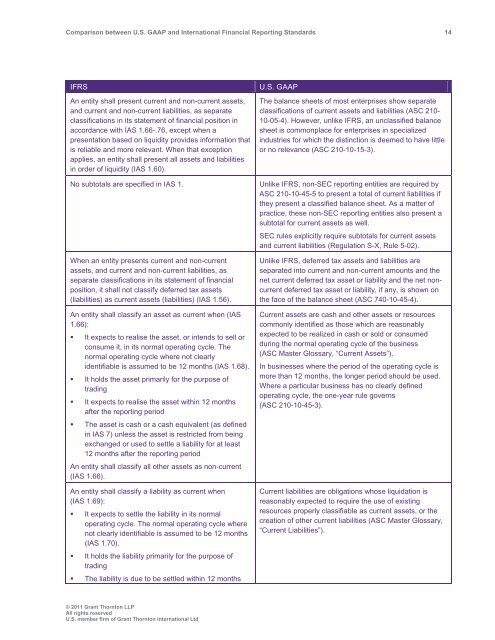Comparison between U.S. GAAP and International ... - Grant Thornton
Comparison between U.S. GAAP and International ... - Grant Thornton
Comparison between U.S. GAAP and International ... - Grant Thornton
You also want an ePaper? Increase the reach of your titles
YUMPU automatically turns print PDFs into web optimized ePapers that Google loves.
<strong>Comparison</strong> <strong>between</strong> U.S. <strong>GAAP</strong> <strong>and</strong> <strong>International</strong> Financial Reporting St<strong>and</strong>ards 14<br />
IFRS<br />
An entity shall present current <strong>and</strong> non-current assets,<br />
<strong>and</strong> current <strong>and</strong> non-current liabilities, as separate<br />
classifications in its statement of financial position in<br />
accordance with IAS 1.66-.76, except when a<br />
presentation based on liquidity provides information that<br />
is reliable <strong>and</strong> more relevant. When that exception<br />
applies, an entity shall present all assets <strong>and</strong> liabilities<br />
in order of liquidity (IAS 1.60).<br />
No subtotals are specified in IAS 1.<br />
When an entity presents current <strong>and</strong> non-current<br />
assets, <strong>and</strong> current <strong>and</strong> non-current liabilities, as<br />
separate classifications in its statement of financial<br />
position, it shall not classify deferred tax assets<br />
(liabilities) as current assets (liabilities) (IAS 1.56).<br />
An entity shall classify an asset as current when (IAS<br />
1.66):<br />
• It expects to realise the asset, or intends to sell or<br />
consume it, in its normal operating cycle. The<br />
normal operating cycle where not clearly<br />
identifiable is assumed to be 12 months (IAS 1.68).<br />
• It holds the asset primarily for the purpose of<br />
trading<br />
• It expects to realise the asset within 12 months<br />
after the reporting period<br />
• The asset is cash or a cash equivalent (as defined<br />
in IAS 7) unless the asset is restricted from being<br />
exchanged or used to settle a liability for at least<br />
12 months after the reporting period<br />
An entity shall classify all other assets as non-current<br />
(IAS 1.66).<br />
An entity shall classify a liability as current when<br />
(IAS 1.69):<br />
• It expects to settle the liability in its normal<br />
operating cycle. The normal operating cycle where<br />
not clearly identifiable is assumed to be 12 months<br />
(IAS 1.70).<br />
• It holds the liability primarily for the purpose of<br />
trading<br />
• The liability is due to be settled within 12 months<br />
U.S. <strong>GAAP</strong><br />
The balance sheets of most enterprises show separate<br />
classifications of current assets <strong>and</strong> liabilities (ASC 210-<br />
10-05-4). However, unlike IFRS, an unclassified balance<br />
sheet is commonplace for enterprises in specialized<br />
industries for which the distinction is deemed to have little<br />
or no relevance (ASC 210-10-15-3).<br />
Unlike IFRS, non-SEC reporting entities are required by<br />
ASC 210-10-45-5 to present a total of current liabilities if<br />
they present a classified balance sheet. As a matter of<br />
practice, these non-SEC reporting entities also present a<br />
subtotal for current assets as well.<br />
SEC rules explicitly require subtotals for current assets<br />
<strong>and</strong> current liabilities (Regulation S-X, Rule 5-02).<br />
Unlike IFRS, deferred tax assets <strong>and</strong> liabilities are<br />
separated into current <strong>and</strong> non-current amounts <strong>and</strong> the<br />
net current deferred tax asset or liability <strong>and</strong> the net noncurrent<br />
deferred tax asset or liability, if any, is shown on<br />
the face of the balance sheet (ASC 740-10-45-4).<br />
Current assets are cash <strong>and</strong> other assets or resources<br />
commonly identified as those which are reasonably<br />
expected to be realized in cash or sold or consumed<br />
during the normal operating cycle of the business<br />
(ASC Master Glossary, “Current Assets”).<br />
In businesses where the period of the operating cycle is<br />
more than 12 months, the longer period should be used.<br />
Where a particular business has no clearly defined<br />
operating cycle, the one-year rule governs<br />
(ASC 210-10-45-3).<br />
Current liabilities are obligations whose liquidation is<br />
reasonably expected to require the use of existing<br />
resources properly classifiable as current assets, or the<br />
creation of other current liabilities (ASC Master Glossary,<br />
“Current Liabilities”).<br />
© 2011 <strong>Grant</strong> <strong>Thornton</strong> LLP<br />
All rights reserved<br />
U.S. member firm of <strong>Grant</strong> <strong>Thornton</strong> <strong>International</strong> Ltd
















